|
[Editor's note: We gratefully acknowledge a generous contribution, with a
written permission, of this paper of Tim Beal to ICAS. : sjk] Constructive Engagement Offers Solutions Tim Beal School of Marketing and International Business Victoria University of Wellington, New Zealand Tim.Beal@vuw.ac.nz http://www.vuw.ac.nz/~caplabtb/beal.html Much concern has been expressed in recent years about the 'digital divide', the gap between countries, and people, with access to the digital world and those without. The International Labour Organization in its World Employment Report for 2001 subtitled Life and Work in the Information Economy noted that only 6% of the world's population have ever logged on to the Internet. The gap between the haves and the have-nots was widening, it said, and this would have a profound impact on employment and hence on prosperity. Nowhere is this digital divide more stark than on the Korean peninsula. The difference between North and South is brought home by satellite photographs taken over Northeast Asia at night. Japan, coastal China and South Korea are ablaze with light; in the North there is a glow around Pyongyang but the rest of the country seems dark. FIG 1: NORTHEAST ASIA AT NIGHT  Source: http://antwrp.gsfc.nasa.gov/apod/image/0011/earthlights_dmsp_big.jpg However, dramatic images often disguise more complex realities. The electricity shortage in the North is the main barrier to industrial and agricultural recovery, and mirrors the relative lack of information and communication technologies (ICT). But there is electricity, the Pyongyang Metro does run, some factories operate, and there are reports of a quickening of economic activities. Similarly, there are computers, internet-related activities and even centres of excellence in the North. Not much in contrast to the South, it is true, but probably much higher in relation to its currently depressed GDP than many other countries. SOUTH KOREA AT THE LEADING EDGE But first back to South Korea which is one of the most wired countries in the world. In terms of people connected to the Internet South Korea is at the leading edge although the data is all rather uncertain and should be viewed as indicative rather than definitive. Methodologies and definitions differ. The date of latest surveys vary considerably, which makes a great difference in a rapidly evolving situation. The data used here is that assembled by the Irish company Nua, and is the most recent available. Fig 2 shows the number of people online in the leading 'Internet countries', and South Korea comes out at number six, despite having a relatively modest population. FIG 2: NUMBER OF PEOPLE ONLINE 2001 -- TOP COUNTRIES 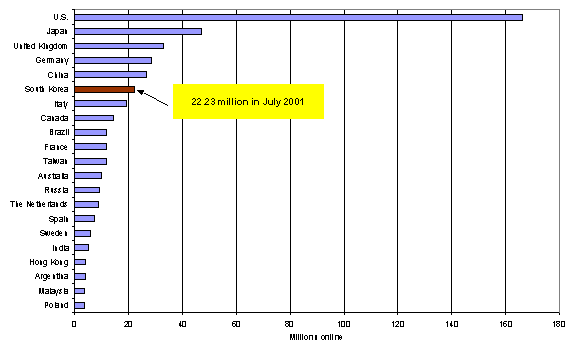 Source Appendix Table A1 Turning to the percentage of people online in Fig 3 we see that South Korea also shines. Here the size of the country is irrelevant so big counties such as China drop out of the picture. Indeed compactness now becomes an asset and the Asian city states of Hong Kong and Singapore both exceed South Korea, as does Taiwan. However, South Korea has a higher percentage of its population online than Japan, which is perhaps the crucial benchmark. FIG 3: PERCENTAGE OF POPULATION ONLINE 2001 -- TOP COUNTRIES 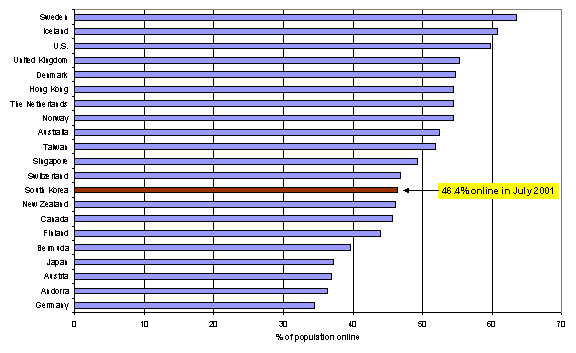 Source: Appendix Table A2 Growth is the third dimension of this particular picture and again South Koreas does surprisingly well. Fig 4 looks at growth in numbers online in the major Asian markets 1997-2001. China not unexpectedly tops the list and early developers such as Singapore where Internet connectivity is now fairly mature, exhibit slow growth. However the robustness of South Korean growth is evident. FIG 4: GROWTH IN NUMBERS ONLINE 1997-2001 IN MAJOR ASIAN MARKETS 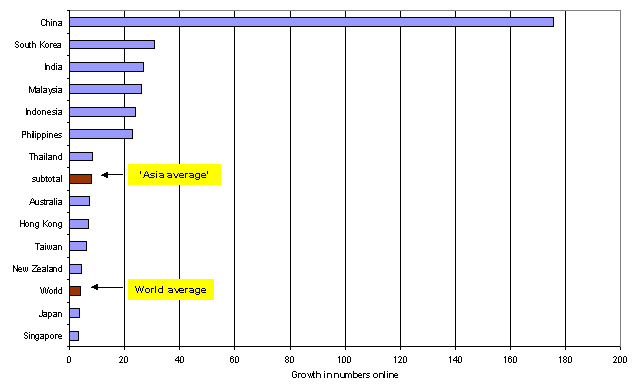 Source: Appendix Table A3 The number of people online is, at best, a very rough measure which leaves alls sorts of things out of account -- who they are (age, occupation, urban or rural, sex...), what they use it for and how intensively, and so on. We know from other sources that South Koreans use the Internet more than anyone else, spending twice as much time online as Americans.1 There are also more likely to use e-commerce sites, and the gender Internet gap is probably the world's smallest --one survey found that 52% users were male and 48% female.2 However the Internet is only one part, albeit a crucial part, of a wider technological environment. TECHNOLOGY ACHIEVEMENT INDEX A recent, and authoritative attempt at capturing that is provided by the 'Technology Achievement Index' (TAI) of the United Nations Development Programme (UNDP). This composite index brings together data on technology creation (patents granted, receipts of royalties and license fees), diffusion of recent innovations (internet hosts, high- and medium-technology exports), diffusion of old inventions (telephones, electricity) and human skills (mean years of schooling, gross tertiary science enrolment ratio). The countries are grouped into five categories -- leaders (18), potential leaders (19), dynamic adopters 26), marginalized (9) others (90). The TAI is not calculated for the last category, because of lack of data, and they are not ranked. Where do the two Koreas fit into this? North Korea is not mentioned at all, presumably because of lack of available data (where it would rank if the data were available is an intriguing question). However, there is not shortage of data for South Korea and the UNDP ranks it fifth in the world ahead of The Netherlands at no. 6 (and Britain at 7). FIG 5: REPUBLIC OF KOREA IN UNDP TECHNOLOGY ACHIEVEMENT INDEX (TAI) 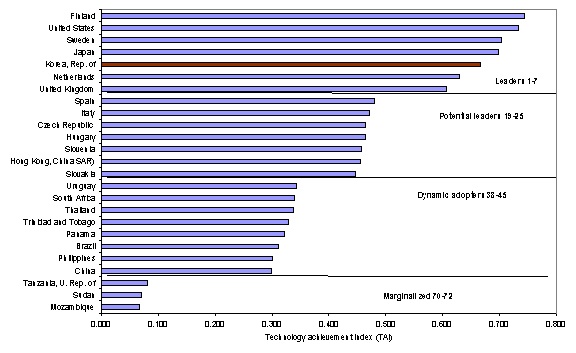 Source: Appendix Table 4 NORTH KOREA - COMPUTER CRAZY DESPITE THE CRISIS In comparison with this it would seem that the North has scarcely commenced the digital revolution. But things can change rapidly in the digital world and if the overarching political and economic problems can be overcome we may see surprisingly rapid process. North and South, Koreans are the same people and South Korea shows there are no cultural barriers as there might conceivably be if we were talking, say, about Afghanistan or Mozambique . In many ways the foundation has been laid, there is a political commitment to the central role of science and technology, and specially ICT, and there are a number of areas where North Korean software is attracting attention. Despite all its problems from shortage of electricity to shortage of computers (let alone shortage of food) North Korea is putting a strong emphasis on ICT.3 One North Korea defector recently talked about the 'computer frenzy': "The nation is reportedly head over heels in love with learning about the information technology sector. .//.. Nowadays all parents insist on pushing their children into computer-related fields and becoming either a scientist for technician. ..//.. It's been quite a while since North Korea fell in love with computers. It is one of the two sectors Kim Jong-il most wishes the North could stand out in - the other being the auto industry...//..North Korea's basic goal is to produce its own computer without having to import any parts from abroad. However that is a long way off, and this is an area that presents an opportunity for South Korean firms. Note the relative success of high-tech companies that made early inroads to the North. While the country is often called "reclusive," it is clearly wide open to those with the latest technology."4 FIG 6: NORTH KOREAN CHILDREN AND COMPUTER FRENZY 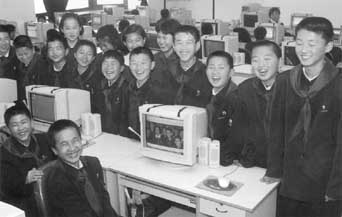 Source:http://www.korea-np.co.jp/pk/167th_issue/IT.jpg Helen-Louise Hunter has argued that Kim Jong Il sees of exports high-tech products (which to a large extent revolve around ICT) as the best way of earning foreign exchange and enabling the industrial base to be rebuilt with 'Western technology'. "He has also put forward an intriguing new theory of economic development based on developing high tech industries, rather than conventional light industries a la the Chinese model, that is more in keeping with South Korea's Hyundai success in moving directly to the use of advanced technology in the production of cars and ships sold around the world. It is a plan that makes sense in terms of North Korea's natural resources and that obviously appeals to Kim's sense of the dramatic and superlative." Crucially, she adds "Kim Chong-il's hopes for the future are not necessarily at odds with U.S. and South Korean long-term interests to the extent that they promote a North Korean future more closely associated with the West."5 Although Pyongyang has often said that its exports of missiles are for commercial reasons and it would negotiate a halt for appropriate compensation the United States has not agreed. 6 Do high-tech exports of a different sort offer a solution that both sides would find acceptable? It seems unlikely that North Korea is going to make major inroads into global ICT markets any time soon, despite occasional headlines - 'DPRK Set on World's Top in IT 7 and 'DPRK to Enter World PC Market'8. However, what is not in doubt is the resolve, nor that it is highly desirable from all points of view. There are formidable barriers but also some surprising points of hope SHORTAGES AND SANCTIONS Computer education is now a compulsory subject at all universities, colleges and middle schools and much attention is given to the subject in official reports. However, what this means in practice is another matter, given not merely the electricity shortage, but a shortage of computers themselves. Even top schools, such as at Moranbong First Senior Middle School in Pyongyang (which I visited in 1998) still have very limited computer facilities according to South Korean reports. A Korea-American religious group, the Institute for Strategic Reconciliation, has launched a campaign to provide computers, software and training in North Korea. The 'IT Forum for Unification', a group of 110 Southern IT experts, has reported that the Pyongyang Informatics Center, one the country's leading research institutes, had requested books. The books specified were all up-to-date, reflecting an awareness of the current literature, but the fact that a top institute did not have them is significant. The choice of topics was also significant, suggesting strategies and priorities that have been corroborated by other reports. The list demonstrated a focus not on in-depth research, but practical and high-profit applications, such as multimedia, graphics and virtual animation. It appears that much of the software is developed under contract for foreign companies. North Korea has been hampered in computerization, as in other fields, by US sanctions and embargo. Although these are less stringent than in the past, they still bar exports by US corporations of 'dual-use goods', that is things which could be used for military purposes. Under the Wassenaar Arrangement this is extended to a wide range of countries, including South Korea, which bans the export of 486 machines and above. There are reports that Pyongyang is now producing Pentium III and Celeron computers. However Mangyongdae Students Palace, Pyongyang Students Palace, and computer classes in Kumsung High and Middle Schools were specifically mentioned as recipients of these computers, suggesting that output is very limited. Estimates of exactly how many computers there are vary widely. One estimate was that there were 100,000 computers in the country, 'most of them 386 class'.9 Another estimate, in January 2001, was that there were slightly more than 3000 'desktops'.10 Nevertheless the North Korean media reports computers are used in a wide variety of industrial applications, including chicken factories. When I visited Mangyongdae Students Palace in 1998 I saw music, crafts and calligraphy classes but no sign of computers. When I returned in July 2001 there were at least three rooms full of computers. The students were virtually all boys -- girls seemed to be still doing embroidery -- which suggest that gender bias is still strong. Women were also not well represented among programmers at the Pyongyang Computer Center, which I also visited. FIG 7: PYONGYANG INFORMATICS CENTER 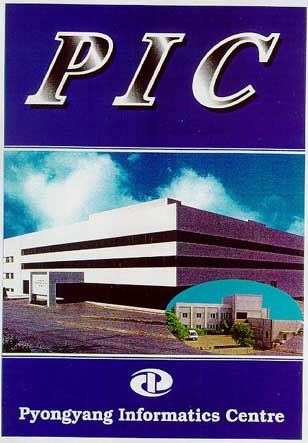 Source: http://www.korea-np.co.jp/pk/152th_issue/PIC.jpg INTERNET In stark contrast to the South's world-class position the Internet currently scarcely exists in the North. There is a network called Kwangmyong [bright star] which is administered by the Central Scientific and Technological Information Agency (CSTIA) and was established in 1997 'to provide materials related with science and technology to people, universities and research institutes of the DPRK'. 11 The CSTIA provides 'technological data-searching, e-mail, website search and file transmissions services...//.. [and] various kinds of foreign science magazines through the network.' 12 [emphasis added] Kwangmyong currently serves 1300 institutions and computers linked to it have increased 4.6 times over two years to July 2001. 13Clearly CSTIA currently acts as a manual gateway to the Internet, and this seems to be done through the existing landline telecommunications system into China. Plans are afoot to establish satellite connections but this does not seem to have eventuated yet.14 A company, owned jointly by North Koreans and Korean-Chinese and run out of Shenyang has launched a commercial email service called 'Silibank' ( 'real profit' ). 15It is expensive and cumbersome -- you have to register and pay a fee even to see the press releases -- and it is uncertain how much business it has picked up. SOFTWARE -- A GROWTH PATH FOR EXPORTS? But it's with software that things are happening. Experts who accompanied Kim Dae-jung to Pyongyang for the summit were impressed by some of the software developed in the North. Optical character recognition, Korean speech recognition and translation programs such as Korea-Japanese and Japanese-Korean have been developed, and multilingual translations programs covering Korean, Japanese, English and Chinese were planned. North Korea has been venturing onto the international market and has displayed its products at the World PC Expo in Japan \in 2001 and is mounting a solo expo of its own in Beijing in April 2002 FIG 8: DPRK SOFTWARE EXPO IN BEIJING 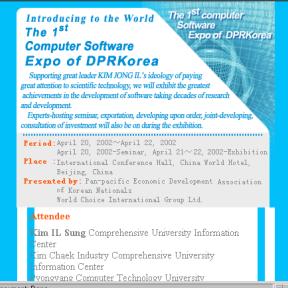 Source: http://www.english.dprkorea.com/notify.php Much of this software is developed in collaboration with foreign companies, mainly South Korean. The (South) Korea Trade Investment Promotion Agency, KOTRA, has identified four reasons for ROK companies to pursue these cooperative ventures:
One fruit of North-South cooperation has been Dinga the lazy cat. This 'brownish little kitty with half open eyes --they get a bit wider when someone takes away its pizza or remote control' was launched on 5 May 2001, Children's Day in both Koreas. It is a joint project between the South's Hanaro Telecom -- which provides the character, stories, dubbing and other sound effects, and the North's animation studio Samcholli, which supplies the high-tech 3-d skills. 17 FIG 9: DINGA THE LAZY CAT 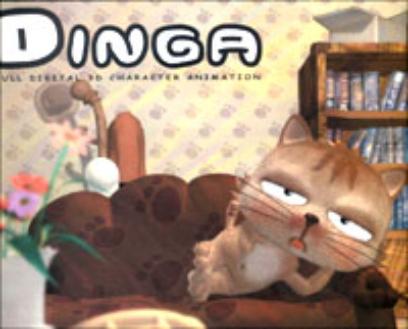 Source: http://english.joins.com/nk/col/Media/Img/dingae.jpg Another prominent North Korean animation units is the SEK Studio which seems to focus on the production of animation for foreign filmmakers, including French, Italian and Spanish companies. This is variously described as the Korea Joint Venture Animated Cartoon Company or the April 26th Children's Film Studio. A report in November 2001 claimed that "Our company, staffed with highly skilled creators and equipped with high performance computers, is capable of responding to any orders." 18 FIG 10: NORTH KOREAN ANIMATION: THE CLEVER BADGER 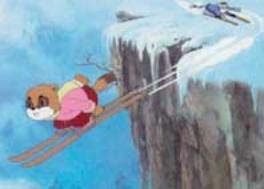 Source: http://www.korea-np.co.jp/pk/151st_issue/2000110802.htm FIG 11: NORTH KOREAN ANIMATION: ARABIAN NIGHTS  Source: http://www.korea-np.co.jp/pk/173rd_issue/2001122606.htm A longer article in December 2001 gave more details of the contractual arrangements with the foreign studies, which go back to 1985. There are now 70 foreign customers. It was said that 'The studio is actively promoting collaborations, contract-basis work and technical exchanges with foreign enterprises in the international cartoon films market and also in the international cartoon film festivals.' 19 It is not stated how much foreign exchange is earned but the company has over 1000 artistic staff. It 'computerizes the scanning, coloring of original pictures and background, animation, editing, special effect and the composition of pictures' and it claimed that its 'animation work is highly regarded in Europe, noted as good as Disney's works.' 20 FIG 12: NORTH KOREAN ANIMATION: LES MISERABLES  Source: http://www.korea-np.co.jp/pk/173rd_issue/2001122606.htm The reference to Disney raises a mystery - and stimulates optimism about the future of US-NK relations even under the shadow of the 'axis of evil' speech. The People's Korea articles mention some titles, which it is claimed that SEK has been involved with "the company has presented such wonderful animation films as Simba, King Lion, Les Miserables, Adventures of Pif and Hercules and Pocahontas to the world". 21Some of those titles seem familiar? Indeed they are. According to a report in JoongAng Ilbo "North Korea has long received orders from the abroad for animation work. North Korean artists worked on Disney's "Lion King", "Hercules", "Pocahontas" and other notable cartoons." 22 The next time President Bush sits down to watch a Disney film he might well contemplate whether peaceful and constructive engagement with North Korea offers a better guarantee of security for the United States, and for the Korea peninsula, than saber rattling. No doubt President Kim Dae-jung could assure him that it does. REFERENCES 'Computer Network Rapidly Expanding in DPRK', People's Korea website, February 2001, http://www.korea-np.co.jp/pk/156th_issue/2001022104.htm 'Dinga the lazy cat may help close gaps', JoongAng Ilbo, 10 January 2002, http://english.joins.com/nk/article.asp?aid=20020110105419&sid=E00 'DPRK Set on World's Top in IT', People's Korea, May 2001, http://www.korea-np.co.jp/pk/161st_issue/2001052702.htm 'DPRK to Enter World PC Market', People's Korea, October 2001, http://www.korea-np.co.jp/pk/168th_issue/2001100502.htm Hunter, Helen-Louise, 'North Korea: Dreaming of High-Tech -- Subsisting on Hand-Outs', ICAS Lecture June 21, 2001, http://www.icasinc.org/s2001/s2001hlh.html International Labour Organization (ILO), 2001, World Employment Report 2001, Life at work in the information economy, Geneva, http://www.ilo.org/public/english/support/publ/wer/index2.htm (Only Overview and Statistical Annex available online) Kim Deok-hyun, 'ROK Shows Lowest Internet Gender Gap in Asia", Korea Times, 3 March 2001, http://www.hk.co.kr/times/200105/t2001050316572540110.htm Kirk, Don, 'North Korea Refuses to Stop Arms Exports, Delegation Says', New York Times, 5 May 2001, http://www.nytimes.com/2001/05/05/world/05KORE.html Korean Animation Films Amazing World, People's Korea website November 2000, http://www.korea-np.co.jp/pk/151st_issue/2000110802.htm 'Korean-made Cartoon Films Win Popular Acclaim among Animation Film Fan in Europe', People's Korea website December 2001 http://www.korea-np.co.jp/pk/173rd_issue/2001122606.htm 'N. Korea Subscribes to Intelsat to Become 145th Member Nation', Yonhap News Agency, 29 May 2001, http://www.yonhapnews.co.kr/news/20010529/2000000000200105291738452.html 'N.K. Introduces First Computer Network System', JoongAng Ilbo, 23 July 2001, via KOTRA website http://www.kotra.or.kr/main/common_bbs/notice_read.php3?board_id=20&pnum=899772&cnum=0 Nam Woo-Suk, 'Current status of Inter-Korean economic cooperation in the IT field, tasks and future outlook', KOTRA website, 25 May 2001, http://www.kotra.or.kr/main/common_bbs/bbs_read.php3?board_id=24&pnum=899995&cnum=0&row_num=1&n_page=1&q_page=1 'North Korea Launches First E-Mail Service For Foreigners' JoongAng Ilbo, 1 November 2001, via KOTRA website, http://www.kotra.or.kr/main/common_bbs/bbs_read.php3?board_id=20&pnum=899725&cnum=0&row_num=8&n_page=1&q_page=1 'North Korea Produced 1,300 Computers in February', Yonhap News Agency, North Korea This Week, No 138, 17 May 2001, http://www.yonhapnews.net/news/20010517/4801000000200105171154549.html 'Pentium-class Computer Aid to North Korea Debated', Chosun Ilbo, 26 February 2001 via KOTRA website http://www.kotra.or.kr/main/common_bbs/bbs_read.php3?board_id=20&pnum=899927&cnum=0&row_num=76&n_page=8&q_page=1 'Prospects good for unification? Think again, says one scholar', JoongAng Ilbo 12 December 2002, http://english.joins.com/nk/article.asp?aid=20011212165051&sid=F00 'Seoul to help North Korea build satellite-based Internet access system' Korea Herald, 28 June 2001, http://www.koreaherald.co.kr/SITE/data/html_dir/2001/06/28/200106280052.asp 'South Koreans are biggest Net users', South China Morning Post, Friday, 24 August, 2001 'Strategic Plan for IT Revolution in DPRK', People's Korea August 2001, http://www.korea-np.co.jp/pk/167th_issue/2001082504.htm United Nations Development Programme (UNDP), Annual Report 2001, Partnerships to fight poverty United Nations Development Programme, http://www.undp.org/dpa/annualreport2001/ APPENDIX TABLE A1: NUMBER OF PEOPLE ONLINE - TOP 21 COUNTRIES
http://www.nua.ie/surveys/how_many_online/index.html Downloaded December 2001 TABLE A2: PROPORTION OF POPULATION ONLINE -- TOP 21 COUNTRIES
http://www.nua.ie/surveys/how_many_online/index.html Downloaded December 2001 TABLE A3: ASIA/PACIFIC 1997-2001: GROWTH IN NUMBER AND PERCENTAGE ONLINE
Dates are only approximate since there are not surveys available for some countries The last survey in the year is used India November 1997 : 120,000-240,000 midpoint is used for calculation purposes Japan, Malaysia, Thailand: no survey available for 2001 so 2000 used Growth for Thailand is from 1998 Asia % is calculated from the sum of the identified countries TABLE A4: TECHNOLOGY ACHIEVEMENT -- POTENTIAL LEADERS AND DYNAMIC ADOPTERS
Footnotes
| ||||||||||||||||||||||||||||||||||||||||||||||||||||||||||||||||||||||||||||||||||||||||||||||||||||||||||||||||||||||||||||||||||||||||||||||||||||||||||||||||||||||||||||||||||||||||||||||||||||||||||||||||||||||||||||||||||||||||||||||||||||||||||||||||||||||||||||||||||||||||||||||||||||||||||||||||||||||||||||||||||||||||||||||||||||||||||||||||||||||||||||||||||||||||||||||||||||||||||||||||||||||||||||||||||||||||||||||||||||||||||||||||||||||||||||||||||||||||||||||||||||||||||||||||||||||||||||||||||||||||||||||||||||||||||||||||||||||||||||||||||||||||||||||||||||||||||||||||||||||||||||||||||||||||||||||||||||||||||||||||||||||||||||||||||||||||||||||||||||||||||||||||||||||